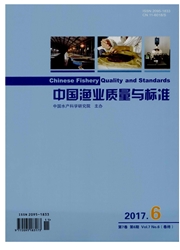

 中文摘要:
中文摘要:
近年来食物引起的过敏性疾病发病率持续增高,严重影响了人们的生活质量。水产品是中国主要的致敏性食物,且东部沿海地区过敏发病率较高。已发现的水产食物过敏原有小清蛋白(parvalbumin)、原肌球蛋白(tropomyosin)、精氨酸激酶(arginine kinase)、肌钙结合蛋白(sarcoplasmic calcium-binding protein)、肌球蛋白轻链(myosin light chain)、肌钙蛋白C(troponin C)和磷酸丙糖异构酶(triosephosphate isomerase)等。水产食物过敏反应存在免疫交叉性,过敏原的抗原表位是引发过敏反应的基础,表位组成和空间构型等特征决定了抗原的特异性。本文着重对国内外水产食物过敏原及其抗原表位的研究现状进行了概述,以期为水产食物过敏疾病诊断治疗和低致敏性食品开发提供指导。
 英文摘要:
英文摘要:
In recent years, the prevalence of food allergic diseases has risen; it seriously impacts upon the quality of people' s lives. Seafood is the major allergenic food in China, and the prevalence of seafood allergies in the eastern coastal areas was very high. The allergens of seafood are parvalbumin, tropomyosin, arginine kinase, sarcoplasmic calcium - binding protein, myosin light chain, troponin C, triosephosphateisomerase and so on. Seafood often has the cross - immunoreactivity ; their epitopes are the basis of the occurrence of allergic reaction. The specificity of the al- lergen depends on the characteristics of its epitopes, such as composition and conformational structure. This paper re- viewed the research of seafood allergens and its epitopes, with a view to providing guidance for the diagnosis and treat- ments of seafood allergic diseases and the development of hypoallergenic food products.
 同期刊论文项目
同期刊论文项目
 同项目期刊论文
同项目期刊论文
 Purification, cloning, and immunological characterization of arginine kinase, a novel allergen of oc
Purification, cloning, and immunological characterization of arginine kinase, a novel allergen of oc Induction of mud crab (Scylla paramamosain) tropomyosin and arginine kinase specific hypersensitivit
Induction of mud crab (Scylla paramamosain) tropomyosin and arginine kinase specific hypersensitivit Purification and characterisation of sarcoplasmic calcium-binding protein, a novel allergen of red s
Purification and characterisation of sarcoplasmic calcium-binding protein, a novel allergen of red s Purification, characterization and immunoreactivity of tropomyosin, the allergen in Octopus fangsiao
Purification, characterization and immunoreactivity of tropomyosin, the allergen in Octopus fangsiao 期刊信息
期刊信息
